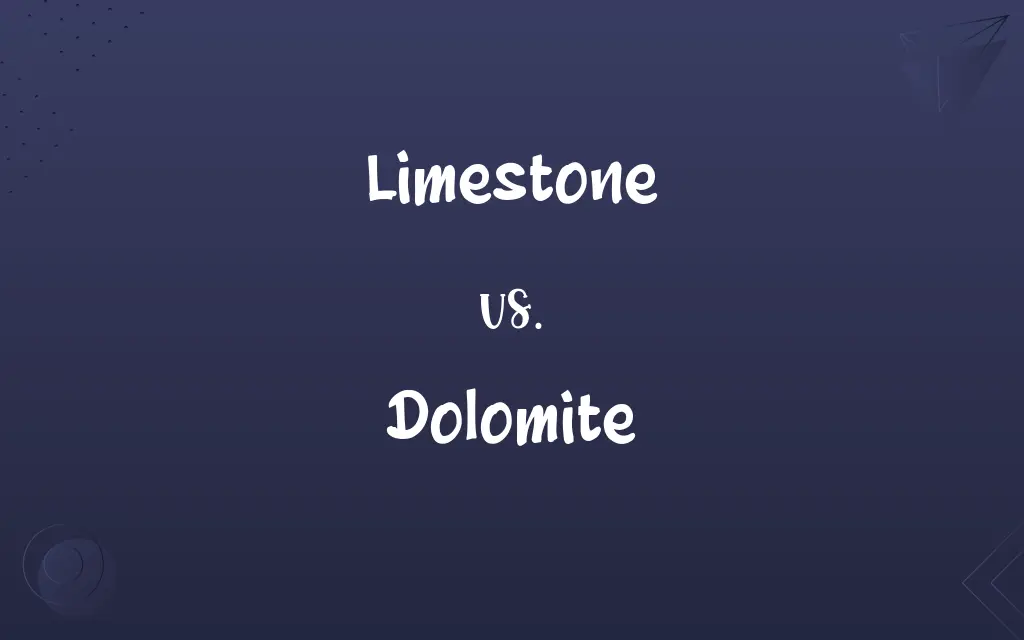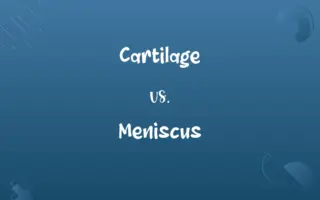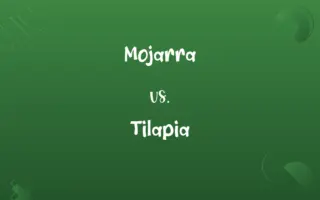Limestone vs. Dolomite: Know the Difference

By Shumaila Saeed || Updated on December 25, 2023
Limestone is a sedimentary rock mainly composed of calcium carbonate, while dolomite is a mineral rock containing calcium magnesium carbonate.

Key Differences
Limestone is primarily composed of calcite (calcium carbonate) and forms in clear, warm, shallow marine waters. Dolomite, also known as dolostone, contains the mineral dolomite (calcium magnesium carbonate) and often forms from limestone.
Shumaila Saeed
Nov 30, 2023
Limestone is used in construction, cement manufacturing, and as a soil conditioner. Dolomite is used as an ornamental stone, a concrete aggregate, and a source of magnesium oxide.
Shumaila Saeed
Nov 30, 2023
Limestone reacts vigorously with acids, releasing carbon dioxide. Dolomite reacts less intensely with acids compared to limestone, due to the presence of magnesium.
Shumaila Saeed
Nov 30, 2023
The formation of limestone is through the accumulation of shell, coral, algal, and fecal debris. Dolomite can form as a direct sedimentary deposit or through the alteration of limestone by magnesium-rich groundwater.
Shumaila Saeed
Nov 30, 2023
Limestone often contains fossils and can have a smooth to granular texture. Dolomite is typically more crystalline in texture and can exhibit a variety of colors due to impurities.
Shumaila Saeed
Nov 30, 2023
ADVERTISEMENT
Comparison Chart
Primary Composition
Calcium carbonate (calcite)
Calcium magnesium carbonate (dolomite mineral)
Shumaila Saeed
Nov 30, 2023
Uses
Construction, cement, soil conditioning
Ornamental stone, concrete aggregate, magnesium source
Shumaila Saeed
Nov 30, 2023
Formation Process
Accumulation of marine debris
From limestone or sedimentary deposition
Shumaila Saeed
Nov 30, 2023
Texture and Appearance
Often contains fossils, can be smooth
More crystalline, varies in color
Shumaila Saeed
Nov 30, 2023
ADVERTISEMENT
Limestone and Dolomite Definitions
Limestone
A sedimentary rock primarily made of calcium carbonate.
The Great Pyramids of Egypt are made from limestone blocks.
Shumaila Saeed
Nov 24, 2023
Dolomite
A mineral rock containing calcium magnesium carbonate.
Dolomite is used as a building stone and in the production of ceramics.
Shumaila Saeed
Nov 24, 2023
Limestone
A rock often formed from marine organisms' skeletal fragments.
Limestone cliffs often contain fossilized remains of ancient sea creatures.
Shumaila Saeed
Nov 24, 2023
Dolomite
Used as a refractory material and a source of magnesium.
In the steel industry, dolomite is used for its refractory properties.
Shumaila Saeed
Nov 24, 2023
Limestone
Reacts with acids to produce carbon dioxide.
Geologists use acid to test rocks for limestone due to its fizzing reaction.
Shumaila Saeed
Nov 24, 2023
ADVERTISEMENT
Dolomite
Forms from limestone or direct sedimentary processes.
Dolomite often forms from limestone modified by magnesium-rich groundwater.
Shumaila Saeed
Nov 24, 2023
Limestone
Used widely in construction and for making cement.
Limestone is crushed to make aggregates for concrete production.
Shumaila Saeed
Nov 24, 2023
Dolomite
Can exhibit a crystalline structure and a variety of colors.
Pink dolomite is used decoratively due to its unique color.
Shumaila Saeed
Nov 24, 2023
Limestone
Commonly found in shallow, warm marine waters.
The Caribbean Sea has extensive limestone formations.
Shumaila Saeed
Nov 24, 2023
Dolomite
Reacts less vigorously with acids than limestone.
When exposed to acid, dolomite shows a slower, less intense reaction than limestone.
Shumaila Saeed
Nov 24, 2023
Limestone
A common sedimentary rock consisting mostly of calcium carbonate, CaCO3, used as a building stone and in the manufacture of lime, carbon dioxide, and cement.
Shumaila Saeed
Oct 19, 2023
Dolomite
A white or light-colored mineral, essentially CaMg(CO3)2, used in fertilizer, as a furnace refractory, and as a construction and ceramic material.
Shumaila Saeed
Oct 19, 2023
Limestone
An abundant rock of marine and fresh-water sediments; primarily composed of calcite (CaCO3); it occurs in a variety of forms, both crystalline and amorphous.
Shumaila Saeed
Oct 19, 2023
Dolomite
(mineral) An evaporite consisting of a mixed calcium and magnesium carbonate, with the chemical formula CaMg(CO3)2; it also exists as the rock dolostone.
Shumaila Saeed
Oct 19, 2023
Limestone
A rock consisting chiefly of calcium carbonate or carbonate of lime. It sometimes contains also magnesium carbonate, and is then called magnesian or dolomitic limestone. Crystalline limestone is called marble.
Shumaila Saeed
Oct 19, 2023
Dolomite
A mineral consisting of the carbonate of lime and magnesia in varying proportions. It occurs in distinct crystals, and in extensive beds as a compact limestone, often crystalline granular, either white or clouded. It includes much of the common white marble. Also called bitter spar.
Shumaila Saeed
Oct 19, 2023
Limestone
A sedimentary rock consisting mainly of calcium that was deposited by the remains of marine animals
Shumaila Saeed
Oct 19, 2023
Dolomite
A kind of sedimentary rock resembling limestone but consisting almost entirely of the mineral dolomite
Shumaila Saeed
Oct 19, 2023
Dolomite
A light colored mineral consisting of calcium magnesium carbonate; a source of magnesium; used as a ceramic and as fertilizer
Shumaila Saeed
Oct 19, 2023
Repeatedly Asked Queries
Can dolomite be used in construction?
Yes, dolomite is used in construction as a building stone.
Shumaila Saeed
Nov 30, 2023
Does limestone react with acid?
Yes, limestone reacts vigorously with acids, releasing carbon dioxide.
Shumaila Saeed
Nov 30, 2023
What are the uses of limestone in construction?
Limestone is used in building materials and for making cement.
Shumaila Saeed
Nov 30, 2023
What minerals are in dolomite?
Dolomite contains calcium magnesium carbonate.
Shumaila Saeed
Nov 30, 2023
Is limestone used in agriculture?
Yes, limestone is used as a soil conditioner in agriculture.
Shumaila Saeed
Nov 30, 2023
Are fossils found in limestone?
Yes, limestone often contains fossils from ancient marine organisms.
Shumaila Saeed
Nov 30, 2023
What makes dolomite distinct in appearance?
Dolomite can exhibit various colors due to impurities, making it distinct.
Shumaila Saeed
Nov 30, 2023
How is dolomite formed?
Dolomite can form from limestone or as a direct sedimentary deposit.
Shumaila Saeed
Nov 30, 2023
What is limestone mainly composed of?
Limestone is primarily composed of calcium carbonate.
Shumaila Saeed
Nov 30, 2023
What is the texture of dolomite?
Dolomite typically has a more crystalline texture.
Shumaila Saeed
Nov 30, 2023
Is dolomite used in the steel industry?
Yes, dolomite is used in the steel industry for its refractory properties.
Shumaila Saeed
Nov 30, 2023
Can limestone be used for water treatment?
Yes, limestone is used in water treatment and purification processes.
Shumaila Saeed
Nov 30, 2023
Can dolomite be used as a decorative stone?
Yes, dolomite is often used as an ornamental and decorative stone.
Shumaila Saeed
Nov 30, 2023
What environments does limestone typically form in?
Limestone typically forms in warm, shallow marine waters.
Shumaila Saeed
Nov 30, 2023
Is dolomite a source of magnesium?
Yes, dolomite is an important source of magnesium.
Shumaila Saeed
Nov 30, 2023
Can limestone improve the drainage of clay soils?
Yes, adding limestone can improve the drainage and structure of clay soils.
Shumaila Saeed
Nov 30, 2023
How is limestone used in the cement industry?
Limestone is a key ingredient in the production of cement.
Shumaila Saeed
Nov 30, 2023
What are the industrial uses of dolomite?
Dolomite is used in industries like steel, ceramics, and as a refractory material.
Shumaila Saeed
Nov 30, 2023
Does dolomite react with hydrochloric acid?
Yes, dolomite reacts with hydrochloric acid, but less vigorously than limestone.
Shumaila Saeed
Nov 30, 2023
How does limestone benefit soil?
Limestone improves soil pH balance and provides essential calcium.
Shumaila Saeed
Nov 30, 2023
Share this page
Link for your blog / website
HTML
Link to share via messenger
About Author
Written by
Shumaila SaeedShumaila Saeed, an expert content creator with 6 years of experience, specializes in distilling complex topics into easily digestible comparisons, shining a light on the nuances that both inform and educate readers with clarity and accuracy.




































































